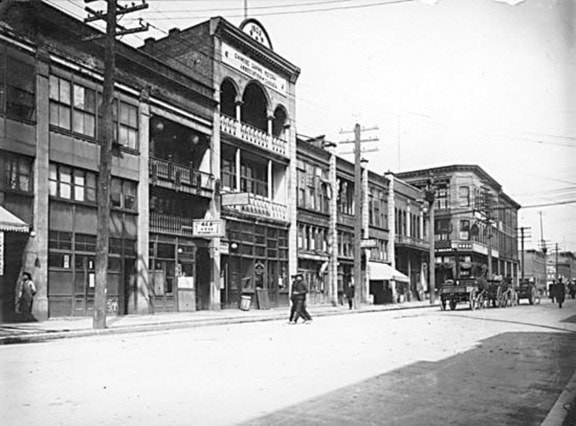Going back, way back, perhaps as much as 14,000 years, archaeologists have been examining the seabed off Haida Gwaii in search of an ancient civilization.
^
There's just no end to current news with historical links and/or historical significance so, for today, a grab bag of recent headlines of interest.
First up, in November, we lost what was said to be "Canada's first cinema" when fire gutted the Robillard Building on St. Laurent Boulevard in Montreal's Chinatown. The historic structure was seen to be doomed, alas, from the moment firefighters arrived on the scene. Originally, in the days of vaudeville, the structure had been the 300-seat Palace Theatre. In June 1896 Louis Minier used a room in the Robillard to "project the first indoor moving picture film in Canada, using the famous Lumiere brothers' cinematographe".
Speaking of Chinatowns, fear has been expressed for the future of Vancouver's unique cultural character.
A perfect storm of changing demographic and affordability has made it a prime target for redevelopment. Established in the 1880s by Chinese immigrants, many of whom had come to Canada to build the trans-continental railway, Vancouver's Chinatown is one of the oldest in the country. Now this historic conclave is under siege by developers wanting to build new and bigger buildings. For what it's worth, the City of Vancouver has imposed protection of its historic building facades.
Also in the news, B.C. Ferries is in the process of retiring and disposing of two of its Queens from the days of (W.A.C.) "Bennett's Navy."
They're the same age as Black Ball Ferry Line's MV Coho which continues to connect Victoria and Port Angeles, Washington, just as it's been doing for 57 years. It's interesting to note that the Queens are considered to have outlived their usefulness and likely are headed for the scrapyard. But the faithful Coho, like that battery-powered rabbit, just keeps on trucking...
Going back, way back, perhaps as much as 14,000 years, archaeologists have been examining the seabed off Haida Gwaii in search of an ancient civilization. Not quite Atlantis calibre, although we're talking several hundred metres deep, but it would be, if confirmed, "the earliest evidence of human habitation in Canada".
Why Haida Gwaii? Because the UVic team, using the latest in autonomous underwater camera vehicles, has noted "really interesting looking targets on the sea floor that, [to] an archaeologist, they look like they could be cultural," UVic's Quentin Mackie told The Canadian Press in September 2014.
Mackie has been studying the area for years and has come to believe that ancient residents harvested salmon there when Haida Gwaii's two main islands, Graham and Moresby, were one and "stretched well across Hecate Strait towards the mainland".
With the help of Parks Canada and armed with detailed scans of the sea floor, the expedition used underwater sonar to search and to detect what was thought to be at least one stone weir — a man-made channel used to corral fish.
Radio-carbon dating from another architectural site on the island suggests that the weir could be as much as 13,800 years old. It's intriguing to note that the application of computer-age technology dovetails with First Nations oral history.
(I should point out that, in past ages, the sea floor was 100 metres lower than today and Moresby Island was twice as large.)
A second Haida Gwaii expedition in the summer of 2014, this one by Parks Canada and the Underwater Archaeological Society of B.C., was a two-week-long search for any of the dozen shipwrecks known to have occurred in these stormy waters of the Gwaii Haanas National Marine Conservation Area Reserve. Not all were victims of storm, however, the trading vessels Ino and Resolution having been captured and sunk by the Haida in 1794.
The previous year, police in West Vancouver were looking for a shipwreck, too. More specifically, part of a shipwreck, the propeller from a Prohbition-era rumrunner. Stolen for a second time from a resident's yard, it was said to be from a rumrunner used by the notorious Al Capone in the 1920s. The propeller isn't a featherweight, either, weighing 136 kilograms, meaning that thieves had to use a winch to load it into their vehicle.
Speaking of stolen items, in June 2016 a program seven years and millions of dollars in the making was launched by UVic and the Nikkei National Museum and Cultural Centre in Burnaby. 'Landscape of Injustice' is a new look at the infamous internment of Japanese Canadians during the Second World War, this one focussing on the seizure and dispensation of their property upon their being shipped to internment camps for the duration.
It's "a broad story, and it's about human rights and social justice," said Sherry Kajiwara, the centre's director and curator.
Proving once again that all 'news' isn't new at all.
^
